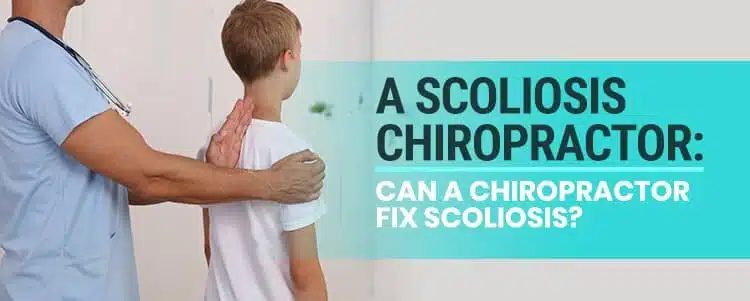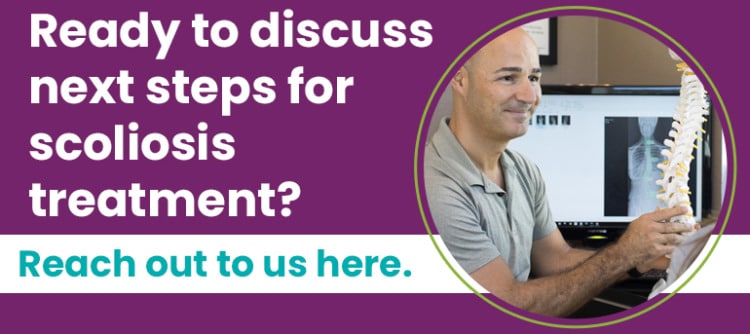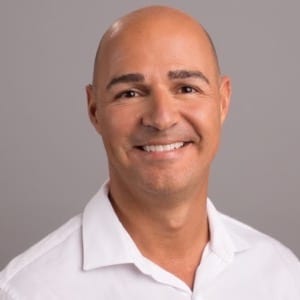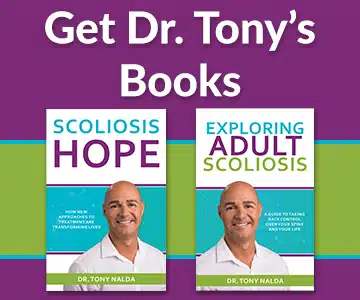As scoliosis is a progressive and incurable condition, the unfortunate truth is that no one can permanently ‘fix’ scoliosis. The positive side of that is while we can’t cure it, we can most certainly treat and manage it effectively.
There are two main treatment paths a person can take, and as a scoliosis-specific chiropractor, I can offer patients a more natural and less invasive approach, including spinal manipulation to manage spine pain and improve spinal alignment.
Can a chiropractor fix scoliosis? No. If you have scoliosis, you can NOT just go to a chiropractor to fix it. If you want to slow or reverse scoliosis progression, then you need to find a scoliosis chiropractor, one who has the proper certifications and training for properly treating scoliosis as a chiropractor.
Before we talk about the benefits of choosing a chiropractor, let’s spend a little time understanding the shortfalls of the traditional treatment path.
The Watch-and-Wait Approach
Consider a typical case of a 12-year-old girl first getting diagnosed with mild scoliosis. If she was seeking out traditional treatment, she would likely be told that her condition was mild. Then, they would just suggest that they would watch and wait to see if and how fast it progressed.
She would likely be told to come back in three-to-six months for another exam and X-ray. The issue I have with this is we know growth spurts are the biggest trigger for progression. We also know that as a progressive condition, virtually every condition is going to get worse.
Let’s say that in the time before her next X-ray, that patient has a huge growth spurt. That could accelerate her scoliosis from mild to moderate; her curvature is now worse as it was left to progress unimpeded. This highlights the risk of the watch-and-wait approach potentially making scoliosis worse.
There is a strong correlation between conditions treated early on in their progressive line and treatment success.
If that patient had come to see me here at the and I diagnosed her, I would have started treatment immediately: proactive versus reactive.
I don’t wait to see how a condition that I know is going to get worse is going to progress before I start treating it. To me, that is wasting valuable treatment time. This is where our conservative approach differs greatly from the traditional path.
Proactive Treatment Benefits
Here at the Center, we start treatment as close to the time of diagnosis as possible. This is beneficial both in terms of treatment and the patient’s experience of that treatment.
Treatment for more severe forms of the condition involves more work and intensity, both for the patient and us. Massage therapy can complement chiropractic care by relieving muscle tension and enhancing blood circulation, which is beneficial for patients undergoing treatment for alignment and pain management.
It is best to start when the condition is in its mildest form. This is when the treatment experience is likely to be easier for the patient and offer better results.
Conditions are also easier to treat early on because the spine gets more rigid as a curvature worsens. This means it is less malleable and harder to manipulate.
Scoliosis develops across a wide spectrum of severity and can be classified as mild, moderate, or severe.
The more severe a condition is, the more likely it is that the patient will experience noticeable symptoms such as postural changes and discomfort. We want to avoid all of this by staying ahead of the curvature by treating it early on, instead of watching and waiting.
Can a Chiropractor Fix Scoliosis?
Adolescent Idiopathic Scoliosis-Specific Chiropractic
Scoliosis is a complex condition for a number of reasons:
- we don’t fully understand its causation,
- it ranges greatly in severity,
- it can take on a variety of forms,
- and no one can tell exactly how much or how fast a condition will progress.
Seeking out help from a general chiropractor will fall short in terms of treatment success. Every patient needs and deserves to find a chiropractor who specializes in scoliosis treatment.
The nature of scoliosis necessitates an integrative approach to treat it effectively. A doctor or chiropractor offering general treatment that is not scoliosis-specific simply won’t have the training. They also won’t have the knowledge or experience to impact a condition as complex as scoliosis.
There is no one-size-fits-all treatment for scoliosis as each case varies greatly from patient to patient. I can honestly say in my years of treating scoliosis, I have never treated two patients the same way.
Here at the Center, we design a fully customized approach that combines the benefits of multiple disciplines to address the characteristics of each individual patient and their condition.
Even within our chosen treatment disciplines, no one on their own can produce the kind of results that our integrative approach delivers.
How a Scoliosis Chiropractor can Treat Scoliosis
Here at the Center, all our treatment forms are scoliosis-specific. We combine chiropractic, therapy, rehabilitation, and corrective bracing.
From a patient’s exam and X-ray, we know everything we need to design an effective treatment plan. We apportion these disciplines accordingly and tweak the plan as we monitor how the spine is responding to treatment.
I perform a number of focused chiropractic adjustments to get the spine to move out of its abnormal curvature. The goal is restoring as much of the spine’s healthy curves as possible.
The treatment focus will be on the entire spine and not just the site of scoliosis. Even losing one of the spine’s healthy curvatures impacts the biomechanics of the entire spine.
Structural Changes
First and foremost, I want to impact the condition on a structural level. Through targeted chiropractic adjustments, we work towards manipulating the curvature to move in the direction we want.
Once I have achieved a curvature reduction, we work towards stabilizing and supporting the spine so that treatment results are sustainable.
We augment these results with other forms of treatment such as therapy, rehabilitation, and corrective bracing. These treatments complement each other by working together to facilitate the curvature reduction.
At-Home Care Scoliosis Exercises
Patients are sometimes disappointed that efforts have to be continued from home and with regular chiropractic care even after a reduction has been achieved. As a progressive and incurable condition, a person is never truly rid of their scoliosis.
We work closely with our patients to ensure treatment results are sustainable, and monitoring and regular chiropractic appointments are often part of that sustainability.
At-home exercises can also be a big part of maintaining flexibility and adequate muscle support for the spine.
As a scoliosis-specific chiropractor, I know the spine, and I know scoliosis. I know how to treat the underlying condition without the need for medication, injections, and invasive procedures such as spinal-fusion surgery.
Here at the Scoliosis Reduction Center®, surgery is always the last resort. No one should consider it without first trying a more natural conservative approach offered by a scoliosis chiropractor.
Can a Chiropractor Heal Your Scoliosis?
What Can a Chiropractor Do for Scoliosis?
A chiropractor who specializes in scoliosis can do a lot for patients, and the condition; they can strengthen the spine, increase its flexibility, and improve its alignment by addressing areas of vertebral subluxation.
A chiropractor can make the spine more responsive to treatment, increasing the likelihood of treatment success.
And perhaps most importantly, a scoliosis-specific chiropractor can help patients avoid the need for invasive surgical treatment in the future.
How Do Chiropractors Treat Scoliosis?
For patients recently diagnosed with scoliosis, the most difficult part of the diagnosis is often learning about the condition’s incurable and progressive nature.
As a progressive condition, scoliosis is virtually guaranteed to get worse over time, and while this means that scoliosis can’t be cured in the traditional sense, it can be highly treatable, particularly with early detection and intervention.
Treatment providers that rely on chiropractic treatment favor a modern conservative scoliosis treatment approach, versus a traditional surgical response, and conservative treatment providers don’t just use chiropractic care to treat scoliosis, but integrate chiropractic care into a proactive treatment plan that relies on the benefits of multiple condition-specific treatment disciplines.
Chiropractors treat scoliosis by working towards adjusting the position of the curve’s most-tilted vertebrae; by repositioning them back into alignment with the rest of the spine, as much of the spine’s healthy curves as possible are being restored, and this also means improving the entire spine’s biomechanics.
Chiropractic treatment for scoliosis can include a variety of techniques and manual adjustments that work together to address areas of vertebral subluxation that don’t just affect the spine itself, but also its surrounding muscles and nerves.
How Often Should You See a Chiropractor for Scoliosis?
As scoliosis is an incurable and progressive condition, it’s important that patients understand that scoliosis treatment is more about maintaining an ongoing condition, than it is about reaching a fixed goal.
When it comes to the frequency of chiropractic visits, each case is unique, but in general, at the onset of treatment, the visits are the most frequent as short intense rounds of treatment have shown positive results, and as structural results are achieved in the form of a curvature reduction, the treatment focus can shift from chiropractic care to increasing core strength through a variety of therapies.
Patient age is an important factor when it comes to the intensity of chiropractic treatment; young patients facing the progressive trigger of growth will need more frequent visits because the focus of treatment is to reduce the scoliotic curve and hold it there despite the constant trigger of growth.
So in cases where counteracting the condition’s progressive nature is the focus of treatment, chiropractic visits will be more frequent than cases where fast progression isn’t such a risk, as in the treatment of adult scoliosis.
Correcting scoliosis means the size of the scoliotic curve has been reduced on a structural level, and increasing core strength means the spine is optimally supported by its surrounding muscles.
Rehabilitation is the portion of treatment that’s ongoing; I compare it to dental patients with orthotic braces needing to wear a retainer following the removal of the braces.
The braces have applied pressure over time that have adjusted the position of the most-crooked teeth, but effort still needs to be made to sustain those results, and the same can be said of continued chiropractic care in scoliosis treatment.
Rehabilitation most often involves a series of custom-prescribed home exercises and continued chiropractic care to further heal and stabilize the spine from home.
So how often a scoliosis patient will need to see their chiropractor is case-specific, but it is important to be aware that continued chiropractic care is often necessary for sustainable long-term treatment results.
Surgery Versus a Chiropractor
I mentioned earlier that one of the main benefits of chiropractic treatment for scoliosis is that surgery can be avoided, and this is referring to spinal fusion, also known as scoliosis surgery
Traditional scoliosis treatment offers a surgical response, but the reality is that many cases of scoliosis don’t require surgical intervention, particularly those that were diagnosed early and responded to with an immediate and proactive treatment plan.
As a progressive condition, the best time to start scoliosis treatment is always now, but traditional scoliosis treatment doesn’t have a strategy for addressing scoliosis while mild; it commonly reacts with a surgical recommendation when/if a patient progresses into the severe classification.
While spinal fusion still has a place in the treatment of severe and/or atypical cases, it’s a risky and invasive procedure that commonly costs the spine in terms of its overall health, strength, and function.
As a healthy spine is so important for quality of life, I feel a conservative chiropractic-centered treatment approach that prioritizes preserving as much of the spine’s natural health, strength, and function as possible should always be attempted first, before turning to invasive spinal surgery.
The results of spinal fusion are permanent, and if a patient is unhappy, or the fusion is unsuccessful, the only recourse is more surgery and more risks.
If the results of conservative treatment prove unsuccessful, there is no harm done, the spine has been protected and its strength has been preserved, so patients can turn to other treatment options unaffected.
How Does a Chiropractor Fix Scoliosis?
How does a chiropractor fix scoliosis is a question I hear a lot, so I’d like to address it because the answer is something patients need to fully understand.
There is no fixing scoliosis in the sense of curing it; scoliosis is an ongoing condition that can be highly manageable, but it isn’t fixable in the curative sense.
People who are diagnosed with scoliosis need to understand that their condition will be life-long, but that doesn’t mean it has to define them or limit their goals.
In fact, there are a number of famous celebrities and professional athletes that didn’t let a scoliosis diagnosis stop them, so I remind patients that even though I can’t fix their scoliosis, I can most certainly help effectively manage the condition so its effects are minimized.
Can A Chiropractor Straighten My Spine?
A commonly-asked question regarding chiropractors and scoliosis, is can a chiropractor straighten my spine?
When scoliosis is present, the spine is misaligned because of the curve’s most-tilted vertebrae at its apex; when the spine is misaligned, its overall function, biomechanics, and health are disrupted.
As a CLEAR-certified scoliosis chiropractor, I know scoliosis, and I know the spine.
Through a series of manual adjustments, and other chiropractic strategies and techniques, I can work towards adjusting the most-tilted vertebrae back into alignment with the rest of the spine, which also helps restore as much of the spine’s natural curves as possible.
Remember, there is a big difference between general chiropractic and scoliosis-specific chiropractic, and the CLEAR chiropractic approach was designed specifically for scoliosis patients and has been in use around the world since 2000.
CLEAR treatment protocols for scoliosis involve integrating multiple condition-specific treatment disciplines to impact the condition on every level.
As a structural condition, this means that scoliosis develops because of an abnormality within the spine itself, so first and foremost, effective treatment has to impact the spine on a structural level, in the form of a curvature reduction.
As tilted vertebrae are adjusted and reclaim their natural position in alignment with the rest of the spine, areas of vertebral subluxation are being addressed, which allows the spine to function optimally.
Can a Chiropractor Fix Scoliosis?
Can A Chiropractor Relieve Scoliosis Pain?
Scoliosis isn’t always painful. Age is a significant predictor of whether or not a person’s scoliosis will be painful, as well as condition severity and the angle of trunk rotation (ATR); it’s the condition’s rotational component that makes scoliosis 3-dimensional as the spine doesn’t just bend unnaturally to the side, but also twists from back to front, front to back.
The more severe the condition (the higher the Cobb angle), and the more twisted the spine is, the more likely it is to be painful, but in the condition’s most-prevalent form, adolescent idiopathic scoliosis, scoliosis is not yet a compressive condition.
Scoliosis doesn’t become compressive until skeletal maturity has been reached; growing spines are experiencing a constant lengthening motion that counteracts the compressive force of a scoliotic curve.
It’s compression of the spine and its surrounding muscles and nerves that is the cause of the majority of condition-related pain.
While postural deviation is the main symptom of scoliosis in children and adolescents, in adults, it’s pain, and that pain can take the form of localized back pain and/or radicular pain felt throughout the body, commonly in the arms, legs, and feet.
In addition, muscle pain can be an issue as the muscles that surround the spine struggle to support its unnatural curve, and can become unbalanced as a result; muscles that are strained and exposed to uneven wear can become stiff, sore, and strained.
Chiropractic care can help with pain management by addressing its underlying cause: the structural nature of the condition itself.
As condition-specific chiropractic care works towards adjusting the position of the most-tilted vertebrae, the spine is becoming aligned again, taking pressure off its surrounding muscles and nerves, reducing compression and uneven forces as the curvature size is reduced on a structural level.
While no one has the power to ‘fix’ scoliosis in the curative sense, the condition can most certainly be managed and treated effectively. Thankfully, the traditional-treatment route is no longer the only choice.
This is a large part of why I wrote Scoliosis Hope: to empower patients with the knowledge that they have more, and better, treatment choices than ever before.
While some still choose the traditional-treatment path, this is the choice most likely to end in invasive and costly spinal-fusion surgery.
In addition to treatment efficacy, the big benefit to walking a different path with a scoliosis chiropractor is that the approach carries few, if any, side effects or risk factors.
Here at the Scoliosis Reduction Center®, all disciplines used to treat our patients are scoliosis-specific. We combine chiropractic, therapy, rehabilitation, and corrective bracing.
Spinal-fusion may be successful in terms of strictly straightening a crooked spine, but that comes at a high cost.
There is a significant loss in flexibility and no guarantee that the patient’s scoliosis won’t continue to progress. There are a lot of unknowns surrounding hardware longevity and potential long-term side effects.
Once spinal-fusion is done, there is no going back. The only way to address emerging issues is with subsequent surgeries, and that is never a good option.
For those wanting to reduce their scoliosis, lessen related symptoms, and gain empowerment through learning how to manage their condition proactively, a scoliosis chiropractor has the tools and experience to do so.

A Scoliosis Chiropractor Answers Your Questions
I am willing to answer your questions… here are some submitted by our email subscribers:
Q: “I have scoliosis — does that mean my child will get it, too?”
A: The quick answer is no. Most cases of scoliosis are idiopathic, which means that there is no single, known cause. Also, we know that scoliosis is not hereditary. Yes, there may be genetic predispositions, but that does not guarantee that a member of a family will develop the condition.
That being said, parents who have scoliosis can be proactive by keeping an eye on their children and watching out for scoliosis symptoms. Although it is not hereditary, family members are often exposed to the same conditions that may contribute to scoliosis. The earlier it is detected, the more simple and effective chiropractic-centered treatment will be.
Some of the early signs to look for include:
- Uneven posture
- One leg seems to be longer than the other
- Clothes fit awkwardly
- There is the presence of a “rib hump”
- The head appears to be “off center” compared to the rest of the body
- Spinal curvature is visible to the naked eye
The bottom line is this: if you have scoliosis, it does not mean that your child will also develop the condition. However, being proactive and aware will help you create the best-case scenario for treating your child’s scoliosis, should they develop the condition.
Q: “What is the Cobb angle?”
A: The Cobb angle is the most widely recognized measurement of a scoliosis curvature. Usually, it is measured by looking at an X-ray, which means that it is a measure of two-dimensional space. This means that the measurement is limited, since scoliosis is a three-dimensional condition. Conventional doctors who do not specialize in scoliosis may be able to tell that an abnormal curvature exists, but they do not have the expertise to measure a curvature accurately by looking at a single X-ray. That’s why the Cobb angle measurement, by itself, can lead to a flawed understanding of the condition.
As a scoliosis chiropractor, I use multiple X-rays from numerous angles to measure the true Cobb angle and gain an accurate sense of the curvature in three dimensions. Scoliosis is treated most effectively as a three-dimensional condition; that’s why we make sure we assess it three dimensions, too.
Q: Is scoliosis surgery inevitable?
A: No. Although observation and surgery are the conventional methods of treatment, patients should understand that surgery doesn’t have to be inevitable. In my opinion, surgery should only be seen as a last resort for patients who have tried chiropractic-centered treatments unsuccessfully, or those whose lives may be threatened without it. In my experience, abnormal curvatures can be treated effectively without surgery.
Q: Is bracing necessary to treat scoliosis?
A: It depends. Scoliosis braces such as the Boston Brace or Milwaukee Brace are commonly prescribed to adolescent patients, but they are nominally effective. Patients who undergo the conventional treatment approach are still placed on a path that leads to surgery.
Here at the Scoliosis Reduction Center®, we use bracing technology for many of our patients, but it is always used in conjunction with chiropractic care, physical therapy and exercise. The braces we use also operate differently than the conventional ones. Traditional braces squeeze the spine, limiting function. Our braces push the spine in a manner that allows for correction of a curvature. They are also easier to wear in addition to being more aesthetically appealing.
Q: Can I die from scoliosis?
A: It is extremely unlikely. Scoliosis doesn’t present a threat to patients’ lives unless the spine’s curvature becomes so severe that it threatens internal organs. This is extraordinarily rare, though. What is more likely to threaten a patient’s life is surgery.
Scoliosis can cause pain, discomfort and emotional hardships, but patients and their families need not worry about it being life threatening. With a chiropractic-centered approach to treatment, curvatures can be reduced, providing relief to the body and its internal organs. When we reduce curvatures, we also reduce the need for surgery in the future.




